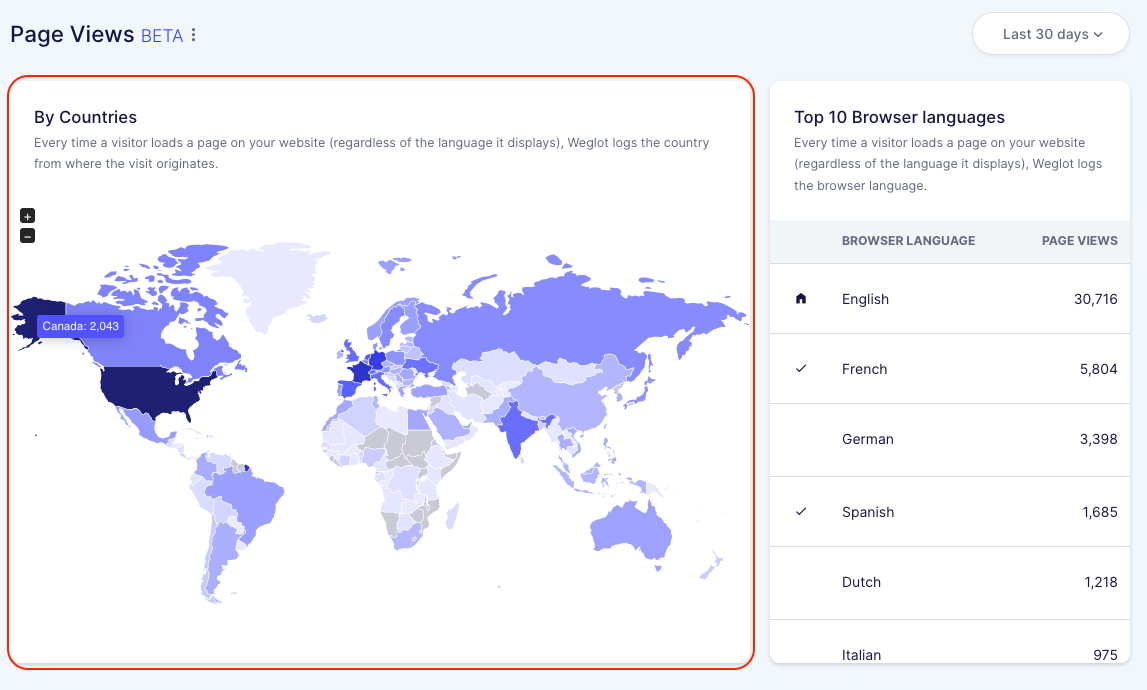How to Build a Successful Multilingual Content Marketing Strategy

If you have an online business and you want it to be successful, you need to understand one general rule: People will not buy anything from you if you haven’t offered them any extra value.
This could be through answering an important question, giving them interesting information, or providing them with a freebie that’s relevant to them.
And one of the best, most well-proven ways of doing all these things is content marketing.
According to Content Marketing Institute research, a solid content marketing strategy allowed 76% of businesses to attract new customers, helped 63% nurture existing leads, and 58% of businesses found it led to revenue and sales.
And if you thought this couldn’t get better, we’re here to bring attention to multilingual content marketing strategies – a magic carpet that can take your business to a whole new world (pun intended).
In this article, we’ll share the secrets of creating a multilingual content strategy and help you understand all the details that can make it successful.
What Is Multilingual Content Marketing?
Multilingual content marketing is the process of successfully translating your content into a target language, as well as localizing and optimizing the content to fit local audiences from diverse linguistic and cultural backgrounds.
In a world where businesses are no longer restricted to a particular geographic location (thanks to worldwide shipping and eCommerce), not making your content cater to different nationalities can lead to many lost opportunities.
Benefits of a Multilingual Content Marketing Strategy
- Extended Reach: Translating and localizing your content can truly break down linguistic and geographical barriers and open you up to entirely new markets. According to a 2014 study by CSA Global (now ERM), 75% of consumers are more likely to buy a product with information in their language. This translates to your brand gaining traction across international markets and resulting in a significant increase in brand visibility and recognition.
- Improved Customer Relationships: An engaging customer relationship hinges on effective communication. Using the native language of your potential customers bridges the gap between understanding and personalized communication. For instance, Uniqlo, a Japanese clothing brand, was lauded for effectively using localized content to engage customers from various locations, like Vietnam.
- Competitive Advantage: Using a multilingual platform provides businesses with an unparalleled edge over competitors who have yet to adopt such inclusive strategies. This was demonstrated by the global technology company Lenovo, which embraced localized content and experienced a surge in international market shares.
- Increased Conversion Rates: Multilingual content often increases trust, engagement, and heightened conversion rates. Offering your site in multiple languages shows customers you’re willing to go the extra mile just to make the shopping experience easier for them, which naturally leads to more people that are willing to spend money.
- Improved Search Engine Optimization (SEO): When you offer content in different languages, you increase the opportunities to organically rank for important keywords, which can help you access untapped international audiences. This strategy drives visibility and traffic, leading search engines to rank your content higher in searches conducted in various languages.
Developing a Multilingual Content Marketing Strategy
A successful global content marketing strategy consists of many different steps that go beyond just translating your website from English to Spanish, for example.
Interestingly enough, it all starts with understanding. Let’s see:
Identify Your Target Languages and Audiences
The basics of any marketing and sales strategy is understanding your audience. Who they are, what they like, and in the case of multilingual content marketing, that includes the language they feel most comfortable communicating with.
To do that, you need to set aside some time to do extensive market research:
- Explore industry reports that reveal regional consumer preferences, behaviors, and trends.
- Dig into the demographics of your users. Analytics from your website and social media channels can reveal important information about your visitors' geographical locations and languages. Discovering that you already have a strong visitor base from Brazil, for instance, signals a need for Brazilian Portuguese content.
- Do a competitor analysis, as it could provide additional insight. If your competitors are gaining traction in Germany, translating your content into German could be a stepping stone to tapping into this market.
- Take the time to understand cultural nuances like idioms, regional trends, and local preferences. Imagine promoting a trendy footwear range in the U.S. that leverages a popular meme. If you attempt to replicate this in Japan without understanding its cultural context, your marketing efforts could fall flat. Encouraging local customer feedback or working with regional experts can help avoid such situations.
- Use tools like Google Analytics to gain audience insights based on their behavior and location. On the other hand, an SEO tool like Ahrefs allows you to identify popular keywords among different language speakers, helping your content creation strategy.
Create and Localize Compelling Content
Now that you know who your audience is, you can start creating content that is specifically tailored to each target market and language. While it may seem like an easy thing to do, it actually goes beyond a simple translation of the existing content.
You have to cater to the cultural preferences, local languages, regional trends, and colloquial expressions of your target audience. In short, interacting in a language isn't just about speaking – it's about connecting.
The American Motors Corporation provides a famous example of exactly what NOT to do. Their car model "Matador" wasn’t received well in Puerto Rico as the term loosely translates to "killer" in Spanish, which wasn’t ideal for a country with an unusually high traffic fatality rate at the time.
To avoid situations like this and achieve effective localization, use localization tools or collaborate with native language experts or creators. For example, Weglot is one such tool that simplifies the translation process while allowing you to perfect translations, preserve cultural nuances, and effectively localize your content.
Maximize Global Reach with Multilingual SEO Strategies
To drive international traffic and enhance your visibility on global search engines, you need to focus on multilingual SEO. The right optimization of your content not only caters to various audiences globally, but significantly strengthens your global reach.
There are three key principles of multilingual SEO:
You can read more about each one in our detailed guides linked above, but keep in mind that it can be a bit overwhelming. This is why we developed Weglot to simplify the process.
Alongside translating website content, we pay attention to many aspects of multilingual SEO, such as metadata translation, creation of subdirectories/subdomains, and the use of hreflang tags.
Measure the Success of Your Multilingual Strategy
You can measure your strategy's effectiveness by using specific Key Performance Indicators (KPIs), such as:
- Generated traffic from the regions you're targeting: Tools like Google Analytics or Weglot’s analytics dashboard provide detailed insights into this KPI, giving you a clear indication of your multilingual content’s reach.

- Conversion rates: Beyond numerical data, qualitative feedback methods such as multilingual customer reviews or testimonials can give insight into customer satisfaction across different regions.
- Bounce rates: Use A/B testing with translated content to potentially mitigate these rates. Watch for common reasons for high bounce rates on multilingual sites, like automatic redirection to an incorrect language version.
- Average session lengths: These could be substantially influenced by cultural relevancy and experience of local internet users. Ensuring your content is culturally appropriate and aligns with local trends can have a direct influence on how long a visitor stays on your site.
It's important to establish a routine to review these KPIs. A monthly or quarterly review can be useful, depending on your needs and results. To set realistic goals, you can benchmark each KPI against industry standards or your own prior performance.
Choosing the Right Tools for Multilingual Content Marketing
You could have the best multilingual strategy in the world, but if you don’t have the right tools to put it into action, you won’t get far.
Let's take a look at the primary types of tools for multilingual content marketing:
- Content Management Systems (CMS): These are a cornerstone for managing and circulating multilingual content. CMS solutions like WordPress, Webflow, or Squarespace could offer robust multilingual support to simplify content creation and distribution needs.
- Translation Tools: These are essential for ensuring your texts are diligently translated and thoughtfully localized for your audience. Tools such as Google Translate can give you a basic translation, but services like Weglot provide advanced localization features that can accurately resonate with your target audience.
- Multilingual SEO Tools: These tools are instrumental in the visibility of your multilingual content in search engine results, augmenting the success of your marketing strategy. Tools like Semrush or Ahrefs can help you with multilingual keyword research, language-specific traffic estimations, and more.
Transitioning into more specific solutions, let's take a closer look at Weglot.

This is a powerful tool that offers businesses all the support they need to successfully execute a multilingual content marketing strategy:
- Comprehensive Language Support: Weglot supports automatic translations into over 110 languages, enabling businesses to reach various markets effortlessly. Beyond broadening your consumer horizon, this feature allows you to cater to the linguistic preference of your audience – a vital aspect of customer engagement.
- Flexible Integration: It integrates harmoniously with popular CMS platforms, allowing businesses to streamline their multilingual content development process. This facilitates easy translation in context, ensuring a seamless user experience across multiple languages.
- Efficacious Translation Management: With Weglot's centralized dashboard, businesses can manage their translations effectively. It enables translation reviews by local experts, ensuring that your brand message won't get lost in translation.

- Multilingual SEO: Search engine optimization is critical for content visibility, and Weglot goes beyond content translation by offering necessary SEO accommodations. Tools like automatic hreflang tag implementation and the creation of language-specific subdomains or subdirectories boost your SEO position in foreign markets. This plays an instrumental role in driving significant traffic and, consequently, business growth.
As Rémy Berda, our Co-founder and CTO, puts it:
“Efficient automation and the opportunity for customization are intertwined in Weglot’s DNA. We get great results for our clients by automating mechanical tasks like translation while leaving room for customization in areas like cultural adaptation and expert review.”
Take Your Content Global with Weglot
A multilingual approach can significantly increase your content reach, allowing you to interact with a larger audience in their preferred language. This, in turn, can help you upgrade user experience, foster a trusted connection, and secure a competitive edge over businesses that limit their content to a single language.
That being said, the road to a successful multilingual marketing strategy involves more than directly translating your existing content. It requires the right set of tools that can not only translate but also localize and optimize content in target languages with precision and efficiency.
Weglot stands out from other translation tools with its ability to seamlessly integrate with various CMS platforms, automate the entire translation and localization process, and enable collaborative editing for refining translations.
So, are you ready to connect with the global market? Start your free trial with Weglot today and begin your multilingual content marketing journey to success!




















